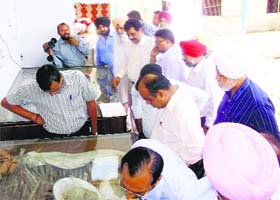Amritsar, Punjab: A team of Archaeological Survey of India (ASI) visited historic Kalianwala Khuh at Ajnala here today. The team comprising, DNA and forensic science experts, besides anthropologists also visited the spot where the mortal remains of the martyrs of the 1857 uprising were excavated from the historic well in March by the Gurdwara Shaheed Ganj Management Committee.
The committee found around 90 skulls, 170 jaws, more than 5000 teeth, Re 1 coin of East India Company, besides two Victoria medals, three lockets and some jewellery from the well.
Around 500 soldiers had started a revolt at Mian Mir Cantonment in Lahore as part of the 1857 uprising and swam across the Ravi to reach Ajnala. Of them, 218 were killed by the British at Dadian Sofian village, near here, while the remaining 282 were incarcerated in a cage-like room, where many of them died of asphyxiation.
The rest were shot dead before their bodies being thrown in the well, which later came to be known as Kalianwala Khu as the British used to call Indians “kale” (black).
The team held discussions with the members of the management committee. ADC Pardeep Sabharwal and SDM, Ajnala, Surinder Singh were also present on the occasion.
The team members said they would soon present their report to the government so that immediate steps could be taken to save the mortal remains of the soldiers.
Surinder Kochhar, a researcher said that many of the skulls dug out from the site had damaged due to improper keep up. He said many of the skulls and jaws could be preserved if immediate steps were taken.
Source: The Tribune
 Sikh Sangat News Celebrating Sikh culture and sharing Sikh voices
Sikh Sangat News Celebrating Sikh culture and sharing Sikh voices

